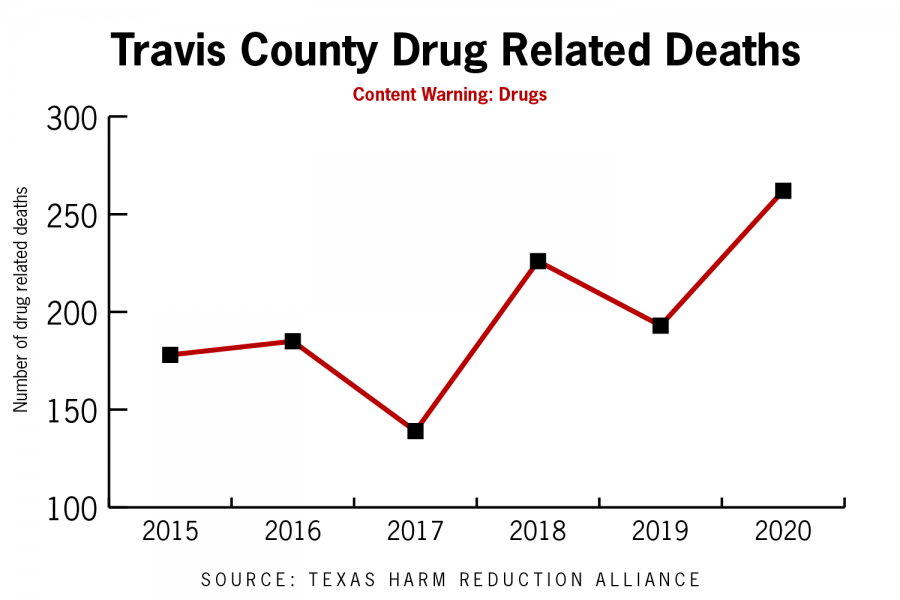As fentanyl-related overdoses increase, UT provides support to students struggling with addiction
November 10, 2021
Local health officials and drug experts say that drug usage has become more common in Travis County due to COVID-19 stressors, leading to a spike in drug overdoses from the potentially lethal opioid fentanyl.
There were 262 drug-related deaths in Travis County in 2020, according to the Texas Department of State Health Services, a 36% increase from the previous year. While it is unknown how many of these deaths are related to fentanyl, Austin EMS officials said the drug is a large contributor to overdoses, especially in cases where the user did not know the substance they were using was laced with fentanyl. The National Institute on Drug Abuse estimates that 59% of drug overdoses involve fentanyl, a highly potent synthetic opioid that is prescribed to treat severe pain and is also used illegally.
Christine Duvauchelle, an associate professor of pharmacology and toxicology, said that while drug users sometimes intend to use fentanyl, other times, their drugs may be unintentionally laced with the substance.
“Fentanyl is particularly dangerous because … there are all these different ways that you can get it into your system,” Duvauchelle said. “And it’s … 80 times more potent than morphine.”
Claire Zagorksi, program coordinator for the pharmacy addiction research and medicine program, said illegal drug suppliers may lace substances with fentanyl due to its affordability and high potency. A briefcase size of fentanyl could achieve the same effect as a trailer filled with heroin, Zagorksi said.
Researchers believe overdose rates spiked during COVID-19, when decreased drug accessibility forced people to buy drugs from new and unfamiliar dealers who may sell higher doses, Zagorski said.
“In the past five years or so … we’re starting to see fentanyl cross contamination into other kinds of drugs,” Zagorski said. “It used to be pretty well isolated in heroin. Now we’re seeing it really consistently in cocaine (and) pressed pills.”
Zagorski said students do not have to worry about cannabis being laced, but almost all other drugs are vulnerable to fentanyl exposure.
The University has several on-campus resources for students in drug recovery, including the Center for Students in Recovery and SHIFT, a program that aims to create open dialogue about substance abuse.
Winston Chapman, the CSR senior program coordinator, said the center provides students with aid that is centered on their personal needs.
“An individual that is in recovery from fentanyl addiction, we’re there just to support them in their pathway,” Chapman said. “Whether it’s … taking medication and working with a therapist, or going to residential treatment.”
SHIFT’s director Kate Lower said students are sometimes afraid to call for help when witnessing or experiencing an overdose. Lower said UT follows an amnesty rule in which students will not face disciplinary action for drug possession or underage drinking if calling for help in a life-threatening emergency, such as an overdose.
SHIFT works with Operation Naloxone, a program that provides Narcan, the prescription drug that treats opioid overdose and recommends all students carry Narcan, which is free through Operation Naloxone or narcan.com.
“Carrying Narcan, for example, (is a) really great harm reduction (strategy),” Lower said. “It’s a spray that you administer to someone through their nose that gets to those opioid receptors and stops an overdose pretty immediately.”












